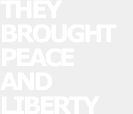
 |
They Brought Peace and Liberty Many of the countries of the Warsaw Pact were forced into a change of paradigm after 1945. No matter whether they were occupied by the German Reich or allied with it - after the War all of these states became countries liberated from Fascism. This interpretation of history was propagated by the Soviet Union, which saw itself as the liberator of these countries. The Second World War was reinterpreted as a past in which anti-Fascist resistance had reached its objective through liberation by the Red Army: namely, a future in an anti-Fascist Socialist state. Austria was also "liberated" in this sense, but it was divided into four different occupation zones. |
| The painting by Sándor Ék depicts the welcome of the Red Army in the ravaged streets of Budapest. A Soviet tank rolls through a street and the enthusiastic inhabitants prepare a jubilant welcome for the troops marching in. Smoke from the final battle can still be seen in the background. The picture, often reproduced in schoolbooks, reflects Soviet ideology in a monumental way, according to which the Red Army liberated Hungary. | |
| The Liberation Statue, above the Danube on the southern bastion of Budapest's Gellért Hill, became the epitome of all liberation monuments. Highly visible, a guardian spirit, or genius, with a palm branch rises above the city. Until 1989 another sculpture depicting a Soviet soldier as liberator stood below the statue. The statue was erected on February 23, 1947, the "Day of the Red Army", and inaugurated by the Hungarian government. The monument has been reproduced innumerable times. Only a few reproductions show the entire ensemble with the Soviet soldier, however. One example of this is a poster from 1952 in commemoration of the 4th of April. It shows a happy Hungarian family in front of the monument with the Soviet soldier, entirely in the spirit of anti-Fascist propaganda. A view from below was chosen to stress the heroism of the family and the sculpture. Both the Hungarian and the Soviet flags are waving, helping the viewer to interpret the scene correctly. | |
| Soon after the end of the War many posters and banners expressing the eternal gratitude of the Czech people to the Soviet Union appeared in Czechoslovakia. This poster is an example: a Soviet soldier bearing a T 34 is in the middle of the poster. The inscription in Russian reads: "Welcome, Red Army". In the shadow of the Russian words is the slogan in Czech: "Praise to the Red Army - Guarantor of the New World". | |




